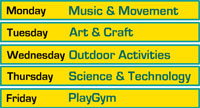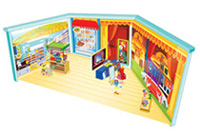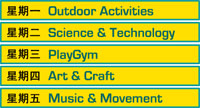English and Chinese Immersion
ENGLISH IMMERSION (HALF-DAY DAILY)
During the half-day English immersion, only English will be spoken in class.
-
7:00 am Arrival & Playtime @ Speech & Drama Room
Half Day/Full Day Programme starts at 7.00am
-
8:00 am Learning Centres & Small Group Interaction
Learning Centres are set up within every classroom to encourage independent and self-directed learning.
-
8:25 am English Language - Knowledge Acquisition
 English is the first language in Singapore and the language most likely spoken at home. Therefore, at ChildFirst, our halfday English programme not only develops your child's competency in the language, it uses the language your child is strong in to help them acquire new knowledge.
English is the first language in Singapore and the language most likely spoken at home. Therefore, at ChildFirst, our halfday English programme not only develops your child's competency in the language, it uses the language your child is strong in to help them acquire new knowledge.Knowledge is introduced through themes such as animals, transportation and occupations. The unique element in ChildFirst's curriculum is our Multiple Intelligences [MI] approach. Within each theme, teaching and learning activities are designed to ensure that children with different learning styles can be engaged to learn better.
10 themes per year, with 10 activities per theme 100 fun-filled, interactive activities per year
Please click on "Multiple Intelligences" for details.
-
9:25 am Morning Snacks
-
9:45 am English Language - Phonics and Reading
 To become skilled readers, children must be able to identify words quickly and accurately. Phonics is a good way to introduce children to the world of reading. Our phonics module helps children to learn the relationship between the letters of written language and the sounds of spoken language. They will then use this knowledge to read, spell and write better.
To become skilled readers, children must be able to identify words quickly and accurately. Phonics is a good way to introduce children to the world of reading. Our phonics module helps children to learn the relationship between the letters of written language and the sounds of spoken language. They will then use this knowledge to read, spell and write better.A good phonics programme enables children to learn the skills meaningfully. Our phonics module lets children learn words in context. Besides phonetic words, children also learn sight words (many of which are high frequency words) so that they can apply their skills in reading real books. The sense of achievement when children learn to read at a young age will spur them to read even more!
-
10:15 am Mathematics
 Children will learn mathematical concepts such as matching, sorting, comparing, ordering, patterning, counting, number value, shape, spatial awareness, and simple measurement. They will also acquire knowledge on mathematical terms including big/small, long/short, heavy/light, more than/less than, same as, one more, one less, count up/down/back, ordinal numbers, altogether, matching, sorting and patterns.
Children will learn mathematical concepts such as matching, sorting, comparing, ordering, patterning, counting, number value, shape, spatial awareness, and simple measurement. They will also acquire knowledge on mathematical terms including big/small, long/short, heavy/light, more than/less than, same as, one more, one less, count up/down/back, ordinal numbers, altogether, matching, sorting and patterns. -
11:00 am Whole Brain Development (conducted in English)
To ensure the holistic development of your child, he/she will be exposed to a variety of programmes on different days of the week. Our whole brain development programmes include Art & Craft for Spatial Intelligence development, and Music & Movement for Musical Intelligence and Bodily-kinesthetic Intelligence development. Over time, your child's unique intelligence profile will emerge giving your child confidence knowing that he/she is good in something.

-
11:30 am Routine Care - Lunch, Bath & Nap
Chinese Immersion (Half-day Daily)
By far, the best way for a pre-schooler to foster a second language is through a language immersion programme. Such a programme is especially useful if the language is not spoken at home. At ChildFirst, your child will be immersed in a Chinese language environment for more than 750 hours every year.
-
1:30 pm Learning Centres and Small Group Interaction
-
1:55 pm Chinese Language - Listening and Speaking
Listening
Children are born with the ability to learn any language and the environment determines the competency of their language. When children are first exposed to a second language, they frequently focus on listening and comprehension.
At ChildFirst, we use the thematic approach to help children comprehend the language. In contrast to the English programme, where children use the English language to acquire knowledge about different themes; here children use their knowledge about the themes to learn the Chinese language.
Speaking
When children are first exposed to a second language, they are often very quiet, speaking little as they focus on understanding the new language. Some of them may also be shy, and are less likely to take risks in using a new language. The child's own motivation and individual differences also play a significant role in second language acquisition.
Language is a skill and like any other skill, it will improve only with constant exporsure and sufficient practice. At ChildFirst, your child will be encouraged to use Chinese language through fun-filled activities, speech and drama, songs and rhymes and classroom interactions.
-
2:55 pm Afternoon Tea
-
3:15 pm Chinese Language - Word Recognition and Reading
Word Recognition
Unlike English, Chinese characters are not phonetic but rather pictorial. Our Chinese Rapid Word Recognition (CRWR) programme will introduce your child to a new but proven method of recognising Chinese characters effectively. Instead of learning discrete characters one at a time, children learn families of words as a group.
The learning of these groups of words are further enhanced and made more interesting via the use of "Rhyme and Stories". Each family of words is then knitted together via a short story told in the form of rhymes to help children remember the characters more effectively and efficiently. The rhymes are animated to make learning even more fun. Together with the high frequency words, children can proceed to reading texts and books at a much younger age.

Reading
The ultimate goal of word-recognition is reading. The focus of the Chinese Step Readers is on reading. It offers children the opportunity to apply their new-found word-recognition skills to reading stories.
The Chinese Step Readers consists of a collection of lively short stories written in words that children have learnt in the Chinese Rapid Word Recognition (CRWR) programme. For example, Story 10 uses words from CRWR Book 1 to Book 10. More words are gradually introduced with each story. This progressive approach helps to build children's confidence and cultivate their interest in reading independently.
Each reader has a reference list which indicates the CRWR book where each word is from. This serves as a useful guide to help children recall the words learnt. With improved Chinese reading skills, your child's interest and self-esteem will flourish and this will help develop your child's Chinese language to its fullest potential.

-
1:30 pm Learning Centres and Small Group Interaction
-
3:45 pm Chinese Language - Real Life Application
Application
Many parents have passed their Chinese exams in school but have difficulty carrying out a simple conversation in Mandarin. This is primarily because they do not have many opportunities to use and practice mandarin.
At ChildFirst, we have a special Speech & Drama room, complete with shops such as a restaurant, supermarket, theatre, hospital and hair salon where children can apply and practice conversing in mandarin through role play. By play acting such as ordering food at a restaurant in Mandarin, they are given opportunies to apply and practice what they have learnt to "real life" situations.
Language is a skill, and like any other skill, it will only improve with constant exposure and sufficient practice. Why worry about whether your child can cope with Chinese in school later on when you can give them a solid foundation and more importantly start them off with an interest in the language now. Learning is painless when you are having fun!

-
4:30 pm Whole Brain Development (conducted in Chinese)

-
5:00 pm 7:00 pm Dismissal and School Bus Departure
Half Day/Full Day Programme Routine Care up to 7pm
